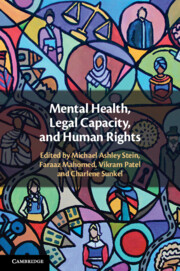22 results
Boxes
-
- Book:
- Mental Health, Legal Capacity, and Human Rights
- Published online:
- 20 August 2021
- Print publication:
- 02 September 2021, pp x-x
-
- Chapter
- Export citation
Contributors
-
- Book:
- Mental Health, Legal Capacity, and Human Rights
- Published online:
- 20 August 2021
- Print publication:
- 02 September 2021, pp xi-xxx
-
- Chapter
- Export citation
Figures
-
- Book:
- Mental Health, Legal Capacity, and Human Rights
- Published online:
- 20 August 2021
- Print publication:
- 02 September 2021, pp viii-viii
-
- Chapter
- Export citation
Preface
-
- Book:
- Mental Health, Legal Capacity, and Human Rights
- Published online:
- 20 August 2021
- Print publication:
- 02 September 2021, pp xxxi-xxxvi
-
- Chapter
- Export citation
Copyright page
-
- Book:
- Mental Health, Legal Capacity, and Human Rights
- Published online:
- 20 August 2021
- Print publication:
- 02 September 2021, pp iv-iv
-
- Chapter
- Export citation
Introduction - A “Paradigm Shift” in Mental Health Care
-
-
- Book:
- Mental Health, Legal Capacity, and Human Rights
- Published online:
- 20 August 2021
- Print publication:
- 02 September 2021, pp 1-16
-
- Chapter
- Export citation
Tables
-
- Book:
- Mental Health, Legal Capacity, and Human Rights
- Published online:
- 20 August 2021
- Print publication:
- 02 September 2021, pp ix-ix
-
- Chapter
- Export citation
Foreword
-
- Book:
- Mental Health, Legal Capacity, and Human Rights
- Published online:
- 20 August 2021
- Print publication:
- 02 September 2021, pp xxxvii-xxxviii
-
- Chapter
- Export citation
Contents
-
- Book:
- Mental Health, Legal Capacity, and Human Rights
- Published online:
- 20 August 2021
- Print publication:
- 02 September 2021, pp v-vii
-
- Chapter
- Export citation

Mental Health, Legal Capacity, and Human Rights
-
- Published online:
- 20 August 2021
- Print publication:
- 02 September 2021
Introduction
-
-
- Book:
- A Better Future
- Published online:
- 06 September 2020
- Print publication:
- 17 September 2020, pp 1-18
-
- Chapter
- Export citation
Copyright page
-
- Book:
- A Better Future
- Published online:
- 06 September 2020
- Print publication:
- 17 September 2020, pp iv-iv
-
- Chapter
- Export citation
Tables
-
- Book:
- A Better Future
- Published online:
- 06 September 2020
- Print publication:
- 17 September 2020, pp ix-x
-
- Chapter
- Export citation
Figures
-
- Book:
- A Better Future
- Published online:
- 06 September 2020
- Print publication:
- 17 September 2020, pp viii-viii
-
- Chapter
- Export citation
Index
-
- Book:
- A Better Future
- Published online:
- 06 September 2020
- Print publication:
- 17 September 2020, pp 473-480
-
- Chapter
- Export citation
Contents
-
- Book:
- A Better Future
- Published online:
- 06 September 2020
- Print publication:
- 17 September 2020, pp v-vii
-
- Chapter
- Export citation
Part II - Deconstructing Marginalisation
-
- Book:
- A Better Future
- Published online:
- 06 September 2020
- Print publication:
- 17 September 2020, pp 175-314
-
- Chapter
- Export citation
Part III - Confronting Marginalisation
-
- Book:
- A Better Future
- Published online:
- 06 September 2020
- Print publication:
- 17 September 2020, pp 315-472
-
- Chapter
- Export citation
Part I - Encountering Marginalisation
-
- Book:
- A Better Future
- Published online:
- 06 September 2020
- Print publication:
- 17 September 2020, pp 19-174
-
- Chapter
- Export citation
Chapter 13 - ‘Invisible’ Disabilities in South Africa’s Higher Education Sector
- from Part II - Deconstructing Marginalisation
-
-
- Book:
- A Better Future
- Published online:
- 06 September 2020
- Print publication:
- 17 September 2020, pp 292-314
-
- Chapter
- Export citation

